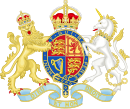
Back Laudabiliter Czech Laudabiliter German Laudabiliter Spanish Laudabiliter French Laudabiliter Irish Laudabiliter ID Laudabiliter Italian Laudabiliter Latin Laudabiliter Dutch Laudabiliter NB
Laudabiliter was a bull issued in 1155 by Pope Adrian IV, the only Englishman to have served in that office. Existence of the bull has been disputed by scholars over the centuries; no copy is extant but scholars cite the many references to it as early as the 13th century to support the validity of its existence.[1] The bull purports to grant the right to the Angevin King Henry II of England to invade and govern Ireland and to enforce the Gregorian Reforms on the semi-autonomous Christian Church in Ireland. Richard de Clare ("Strongbow") and the other leaders of the Anglo-Norman invasion of Ireland (1169–1171) claimed that Laudabiliter authorised the invasion. These Cambro-Norman knights were retained by Diarmuid MacMorrough, the deposed King of Leinster, as an ally in his fight with the High King of Ireland, Ruaidrí Ua Conchobair.
Successive kings of England, from Henry II (1171) until Henry VIII (1542), used the title Lord of Ireland and claimed that it had been conferred by Adrian's successor, Pope Alexander III (c. 1100/1105 – 1181).
After almost four centuries of the Lordship, the declaration of the independence of the Church of England from papal supremacy and the rejection of the authority of the Holy See required the creation of a new basis to legitimise the continued rule of the English monarch in Ireland. In 1542, the Crown of Ireland Act was passed by both the English and Irish parliaments. The Act established a sovereign Kingdom of Ireland with Henry as King of Ireland. A competing, Catholic claim to sovereignty in Ireland was issued in 1555, through Pope Paul IV's bull Ilius, per quem Reges regnant, which bestowed the crown of the Kingdom on Philip II of Spain and Mary I of England.[2]
- ^ Ó Corráin, Donnchadh (1972). Ireland Before the Normans. Gill and Macmillan. p. 26. ISBN 978-0-7171-0559-5.
- ^ "Documents on Ireland". Heraldica. Retrieved 15 September 2021.
© MMXXIII Rich X Search. We shall prevail. All rights reserved. Rich X Search
